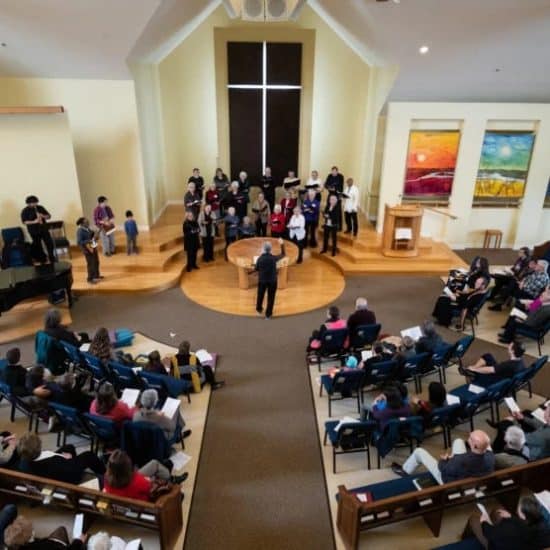“Hi, I’m Joe. Welcome to First Baptist Church!” Long-time church member Joe beams at the visiting couple, while he pumps their hands. “So glad you came!”
Joe spies friends and moves on. The couple looks around, wondering where to sit and what to do next. No one else approaches them. By the time they return to their car, they’ve decided not to return next Sunday.
Often church members believe their congregations to be open and friendly, when, in fact, their efforts are viewed as perfunctory and done because they have to, rather than because they want to be friendly.
Do you consider yours as a friendly congregation? Some churches have discovered just how friendly they are perceived by utilizing a “mystery worshipper.” Unknown to the congregation, the mystery worshipper attends Sunday morning service, taking notes about several aspects of the experience and reporting findings to the pastor.
First-time visitors to a church are six times more likely to return for a second visit to a demonstrably friendly congregation, according to Thom Rainer, president of LifeWay Christian Resources and a former church consultant. Churches cannot rely simply on members to greet people as part of a worship routine, Rainer and other leaders believe. They must intentionally become genuinely friendly.
Karle Vaters, a pastor and Christianity Today blogger, uses a simple five-step approach — his G.I.F.T. Plan — which centers on follow-up and accountability.
Each week, members are encouraged to Greet someone they do not know, to Introduce that person to someone else, and to Follow up the next week by talking with the individual and again introducing him or her to others. Church members also are asked to Thank someone for something the individual did. Leaders are held accountable during administrative meetings, and members report their activity in weekly small groups.
Consultants with Center for Healthy Churches agree that congregations must work at hospitality. A plan to help the church be intentionally friendly is a must, Mike Queen emphasizes. Joel Snider encourages churches to look for ways to “build bonds of communion” among members and guests. Congregations must continually ask: What are effective ways to get people to know each other?
The leaders themselves must model friendliness. Rainer wrote, “[F]riendliness is not contrived or phony.” As models, leaders help their congregations understand that friendliness goes beyond designated welcome times during the service or for a few minutes before or after worship.
A friendly church must have adequate and clear signage within its buildings and have a well-organized greeters’ ministry. The church should have enough greeters to cover the parking areas and building entries. In addition, information centers should be set up in strategic locations and stocked with materials for visitors.
Congregations should have clean, neat buildings, with a safe children’s area. They should provide a guest feedback process so that visitors who wish to comment may do so. To be friendly in today’s technological age, churches also must have up-to-date and user-friendly social media, mobile access and website.
Mystery Worshipper
How would a church know whether it possesses any of these characteristics and at levels visitors would define as “friendly’? Some Baptist churches are turning to “mystery worshippers” to find out. An intentionally friendly church will use “secret guests” on a regular basis, Rainer noted.
In Missouri, Greene County Baptist Association’s congregational health team has developed a mystery worshipper ministry for its cooperating churches. Led by Bob Perry, the congregational health team assists churches with renewal, strategic planning and church health. The mystery worshipper concept grew out of the team’s Making Renewal Intentional ministry.
As use of the MRI process began to slow, the team looked for additional ministries, noted Harold Williams, a retired pastor and longtime team member.
“Bob found the information [for the mystery worshipper ministry] on the Faith Perceptions website,” Williams said. Faith Perceptions (faithperceptions.com) is a for-profit business consultancy that provides services, including the mystery worshipper, to churches and faith-based organizations.
Perry developed a checklist for enlisted mystery worshippers to use and launched the ministry in January 2017. Pastors must request a mystery worshipper, who attends a service and writes a report.
“The pastor decides whether to sit down with the mystery worshipper or to include deacons and other leaders or to have the mystery worshipper come in on Wednesday night and present the report to the congregation,” Associational Director of Missions Michael Haynes explained.
“It is good to get someone else’s view of your church,” Williams said. “It is an interesting way to get a perspective from someone who doesn’t know the ins and outs of your routine. They are able to see from the perspective of an outsider.”
He and his wife had a positive experience as mystery worshippers for a Springfield-area church. The team’s checklist includes most of the characteristics Rainer points out for measuring friendliness. The Williams checked the ease of locating and finding the church, parking, greeters and ushers, ease of finding where to go, the buildings (especially the children’s area) and the service itself (the message, music and invitation).
A church member did provide some instructions as they entered the building. The Williams also asked questions, something many first-time visitors might be reluctant to do, he said. They were pleasantly surprised when a member offered them a mini-tour of the building.
Williams believes an outsider’s view would help the church he visited but acknowledged that he could be considered an “insider” because of his pastoral experience. “I think it can be helpful to a church to have a different set of eyes,” he said. “It doesn’t have to be a pastor-type. … The church might get a different perspective by using a layman.”
While a congregation’s friendliness is generally measured by what takes place within the church walls, it extends into the community, Rainer believes. Members of an intentionally friendly church are involved in the community and “are regularly connecting with non-church members other days of the week,” he wrote.
“Hi, I’m Joe. Welcome to First Baptist Church!” Long-time church member Joe shakes hands with the visiting couple. A member of the congregation’s greeter/usher team, he has learned to be intentionally and authentically friendly. He wants guests to know the church as he knows it — friendly, committed and eager to share Jesus.
“Let me introduce you to our pastor and my friends, Pete and Mary.”
A longtime journalist, Vicki K. Brown currently is a doctoral candidate at the Missouri School of Journalism.


